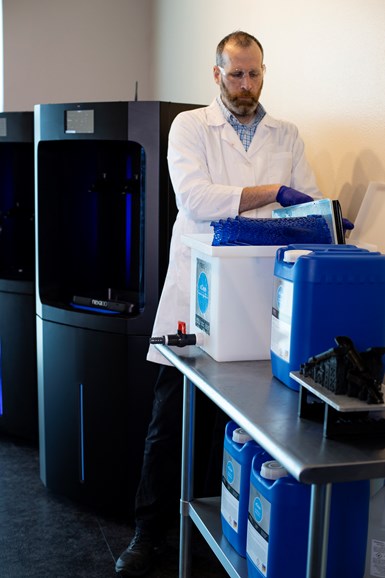Nexa3D xClean Engineered for Resin-Based 3D Printers
Nexa3D xClean eliminates greasy residue typically associated with TPM or DPM, and lasts 3 times longer than isopropyl alcohol with less waste and fewer changeovers.

Nexa3D xClean for resin-based cleaners.
Nexa3D’s xClean is an effective, environmentally friendly washing solvent that is designed to work consistently with most photopolymer 3D printers and resin systems. Nexa3D, the maker of ultra-fast stereolithography production 3D printers, says that xClean has three times the saturation limit of IPA, meaning less waste and fewer changeovers for additive manufacturers.
The solvent is also safer to handle than other cleaning solvents and does not require any special storage or adherence to shipping regulations typically associated with post processing photopolymeric parts, according to the company. It is compatible with most cleaning systems on the market and is made from smaller molecules than TPM or DPM, eliminating the greasy residue that is typically associated with these alternatives.
The xCLEAN can be easily recycled and recovered with a vacuum-assist solvent distillation unit, and it is compatible with most automated washing units on the market today, including closed loop systems. It is not cleared for use when cleaning parts printed from biocompatible resins, and customers are advised to closely follow wash recommendations to preserve the material’s biocompatibility.
Related Content
-
Quadrus: Powder Management Tactics for Tungsten Rhenium and Other AM Alloys
The expert in additive manufacturing of high-value parts for the Defense Department often must change from one exotic material to another in its powder bed machines. Cleaning is a core competency. Here are lessons of this company’s system for working with an ever-changing mix of 3D printed alloys.
-
Additive Manufacturing Versus Cavitation
The design freedom possible with laser powder bed fusion (LPBF) metal 3D printing is making it faster and easier to produce complex anticavitation devices for valves.
-
Velo3D Founder on the 3 Biggest Challenges of 3D Printing Metal Parts
Velo3D CEO and founder Benny Buller offers this perspective on cost, qualification and ease of development as they apply to the progress of AM adoption in the future.











